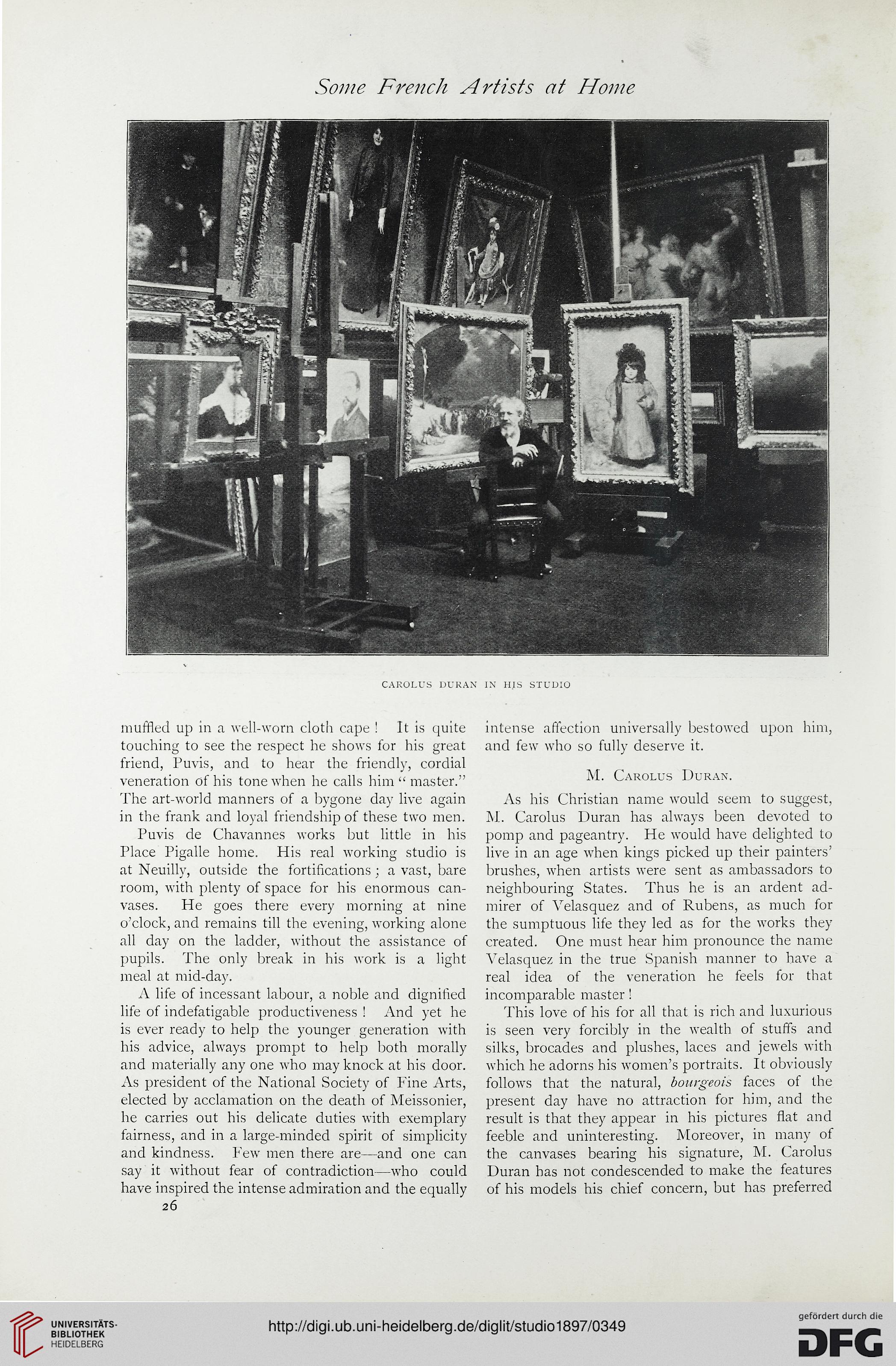Some French Artists at Home
CAROLUS DURAN IN HIS STUDIO
muffled up in a well-worn cloth cape ! It is quite
touching to see the respect he shows for his great
friend, Puvis, and to hear the friendly, cordial
veneration of his tone when he calls him " master."
The art-world manners of a bygone day live again
in the frank and loyal friendship of these two men.
Puvis de Chavannes works but little in his
Place Pigalle home. His real working studio is
at Neuilly, outside the fortifications ; a vast, bare
room, with plenty of space for his enormous can-
vases. He goes there every morning at nine
o'clock, and remains till the evening, working alone
all day on the ladder, without the assistance of
pupils. The only break in his work is a light
meal at mid-da)-.
A life of incessant labour, a noble and dignified
life of indefatigable productiveness ! And yet he
is ever ready to help the younger generation with
his advice, always prompt to help both morally
and materially any one who may knock at his door.
As president of the National Society of Fine Arts,
elected by acclamation on the death of Meissonier,
he carries out his delicate duties with exemplary
fairness, and in a large-minded spirit of simplicity
and kindness. Few men there are—and one can
say it without fear of contradiction—who could
have inspired the intense admiration and the equally
26
intense affection universally bestowed upon him,
and few who so fully deserve it.
M. Carolus Duran.
As his Christian name would seem to suggest,
M. Carolus Duran has always been devoted to
pomp and pageantry. He would have delighted to
live in an age when kings picked up their painters'
brushes, when artists were sent as ambassadors to
neighbouring States. Thus he is an ardent ad-
mirer of Velasquez and of Rubens, as much for
the sumptuous life they led as for the works they
created. One must hear him pronounce the name
Velasquez in the true Spanish manner to have a
real idea of the veneration he feels for that
incomparable master!
This love of his for all that is rich and luxurious
is seen very forcibly in the wealth of stuffs and
silks, brocades and plushes, laces and jewels with
which he adorns his women's portraits. It obviously
follows that the natural, bourgeois faces of the
present day have no attraction for him, and the
result is that they appear in his pictures flat and
feeble and uninteresting. Moreover, in many of
the canvases bearing his signature, M. Carolus
Duran has not condescended to make the features
of his models his chief concern, but has preferred
CAROLUS DURAN IN HIS STUDIO
muffled up in a well-worn cloth cape ! It is quite
touching to see the respect he shows for his great
friend, Puvis, and to hear the friendly, cordial
veneration of his tone when he calls him " master."
The art-world manners of a bygone day live again
in the frank and loyal friendship of these two men.
Puvis de Chavannes works but little in his
Place Pigalle home. His real working studio is
at Neuilly, outside the fortifications ; a vast, bare
room, with plenty of space for his enormous can-
vases. He goes there every morning at nine
o'clock, and remains till the evening, working alone
all day on the ladder, without the assistance of
pupils. The only break in his work is a light
meal at mid-da)-.
A life of incessant labour, a noble and dignified
life of indefatigable productiveness ! And yet he
is ever ready to help the younger generation with
his advice, always prompt to help both morally
and materially any one who may knock at his door.
As president of the National Society of Fine Arts,
elected by acclamation on the death of Meissonier,
he carries out his delicate duties with exemplary
fairness, and in a large-minded spirit of simplicity
and kindness. Few men there are—and one can
say it without fear of contradiction—who could
have inspired the intense admiration and the equally
26
intense affection universally bestowed upon him,
and few who so fully deserve it.
M. Carolus Duran.
As his Christian name would seem to suggest,
M. Carolus Duran has always been devoted to
pomp and pageantry. He would have delighted to
live in an age when kings picked up their painters'
brushes, when artists were sent as ambassadors to
neighbouring States. Thus he is an ardent ad-
mirer of Velasquez and of Rubens, as much for
the sumptuous life they led as for the works they
created. One must hear him pronounce the name
Velasquez in the true Spanish manner to have a
real idea of the veneration he feels for that
incomparable master!
This love of his for all that is rich and luxurious
is seen very forcibly in the wealth of stuffs and
silks, brocades and plushes, laces and jewels with
which he adorns his women's portraits. It obviously
follows that the natural, bourgeois faces of the
present day have no attraction for him, and the
result is that they appear in his pictures flat and
feeble and uninteresting. Moreover, in many of
the canvases bearing his signature, M. Carolus
Duran has not condescended to make the features
of his models his chief concern, but has preferred




